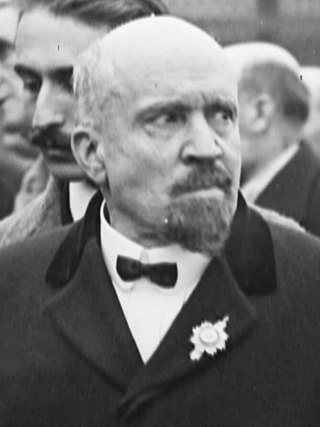
The French Commander-in-Chief, Mediterranean, also known as CECMED is a French Armed Forces regional commander. He commands the zone, the region and the Mediterranean maritime arrondissements. He is usually an admiral of the French Navy, and is under the direct authority of the French Chief of the Defence Staff. As of 2015 the position was held by Admiral Yann Tainguy.

Jean-Marie Charles Abrial was a French Admiral and Naval Minister. He fought in both World wars, and was known mostly for his actions at Dunkirk in 1940.

Anatole-Amédée-Prosper Courbet was a French admiral who won a series of important land and naval victories during the Tonkin Campaign (1883–86) and the Sino-French War.

Émile Paul Aimable Guépratte was a French admiral.

Louis Jaurès was a French naval officer who rose to the rank of rear admiral during World War I. He was the brother of the statesman Jean Jaurès. After retirement he was elected a deputy in the National Assembly of France.

Admiral Pierre-Louis-Charles Rigault de Genouilly was a French naval officer. He fought with distinction in the Crimean War and the Second Opium War, but is chiefly remembered today for his command of French and Spanish forces during the opening phase of the Cochinchina campaign (1858–62), which inaugurated the French conquest of Vietnam.

The French Far East Squadron was an exceptional naval grouping created for the duration of the Sino-French War.

Sébastien-Nicolas-Joachim Lespès was a French admiral who played an important role in naval operations during the Sino-French War, as second-in-command of Admiral Amédée Courbet's Far East Squadron.

Louis Adolphe Bonard was a French admiral who served in the Mediterranean and then for many years in the Pacific. He was governor of French Guiana from 1853 to 1855, and governor of Cochinchina from 1861 to 1863.

Louis René Charles Marie Dartige du Fournet was a French vice admiral during World War I.

Admiral Henri du Couëdic de Kerérant (1868–1947) was a 20th-century French naval officer, serving during the First and Second World Wars. He was the commanding officer of the ship Jean-Bart in the Dardanelles during the Black Sea Mutiny. He restored authority on the ship that had been taken over by the mutineers. From June 1924 he was the commander in chief of the Division Navale du Levant.
Joseph de Ramey de Sugny was a French rear admiral (contre-amiral).

Admiral Antoine Schwerer was a French naval officer. He served in varied roles in many parts of the world, and published a number of technical papers. He rose through the ranks to become an admiral during World War I (1914–18). After retiring in 1924 he was involved with the right-wing and monarchist League of the Action Française. He was president of the League from 1930 to 1935.

Édouard Pottier was a French admiral. During his career, he served in various regions of the world and took part in the operations leading to the occupation of Veracruz in 1861 during the Second French intervention in Mexico and the conquest of Vĩnh Long Province in 1867, which added that territory to French Cochinchina. Promoted to captain in 1886, he served in the Mediterranean and the Levant. Promoted to rear admiral in 1893 and vice admiral in 1898, he served as commander of the International Squadron, a multinational squadron which intervened in the Cretan Revolt of 1897–1898 against the Ottoman Empire. In 1900 he was appointed commander-in-chief of the French Far East Squadron.

Edgar Eugène Humann was a French naval officer. He rose through the ranks to Admiral, and commanded the Far East naval division during the Paknam incident. He served as Chief of Staff of the French Navy in 1894–95.

Louis Charles Georges Jules Lafont was a French naval officer who was Governor of Cochinchina from 1877 to 1879. He joined the navy at the age of sixteen, rose steadily through the ranks, and served in Vietnam, the Philippines, West Africa, the Crimea, the Baltic, the Indian Ocean, China and East Africa. During the Franco-Prussian War of 1870–71 he was given command of land troops. After returning from Cochinchina he held various senior naval commands, including commander in chief of the training squadron from 1885 to 1886.
René-Julien Marquis was a French naval officer who was the father of André Marquis. He served as the préfet maritime of Rochefort, Charente-Maritime and Toulon
Léon Barnaud was a French naval officer, father of Pierre Barnaud and Jacques Barnaud.

Paul Chocheprat was a French naval officer who served during the First World War.

Sosthène Héliodore Camille Mortenol was a senior officer in the French Navy under the French Third Republic and graduate of the École polytechnique. He fought in several of France's colonial campaigns of the era and commanded Paris's anti-aircraft defences during the First World War.

















